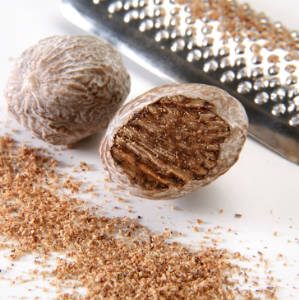Flavorings Category

Includes sweeteners, herbs, spices, chocolate, and extracts.
mayonnaise
See RecipeSource.com postings for Mayonnaise, Homemade Mayonnaise and Eggless Mock Mayonnaise.
Learn moremelegueta pepper
This West African spice is very hard to find in the West. It's similar to cardamom.
Learn moremeloukhia
Middle Eastern cooks use this as an herb in their soups. In other regions, fresh meloukhia is used as a cooking green, much like spinach.
Learn moremenudo mix
Menudo is a Mexican soup made with tripe and hominy. This is the seasoning mix that helps it go down.
Learn moreMerlot
This is a hearty red wine that's similar to a Cabernet Sauvignon, but softer and less tannic. It goes especially well with pork, turkey, and pasta dishes.
Learn moreMexican chocolate
This grainy chocolate is flavored with sugar, almonds, and cinnamon, and used to make hot chocolate and mole sauce. You can buy boxes containing large tablets of this in the Mexican foods aisle of larger supermarkets. Ibarra is a well-respected brand.
Learn moremilk chocolate
If you're looking for a plain chocolate candy bar, this is your best bet. It's like sweet chocolate, only it contains dried milk solids, which gives it a mellow flavor. It's not a good choice for baking, though, since it's sweeter and not as chocolatey as other chocolates. Despite this, many cooks prefer to use milk chocolate chips instead of semi-sweet chocolate chips in their cookies. Be very careful if melting milk chocolate, it scorches very easily.
Learn moremincemeat
Mincemeat is made with dried fruit, nuts, citrus peel, spices, and sometimes brandy, rum, or some other liquor. It used to be made with meat as well, and ready-made jars of it sometimes contain beef suet. It's often used for holiday pies.
Learn moremint
Mint is used throughout the world to flavor everything from lamb to candy. It's also a great garnish and breath freshener. Spearmint is the variety you're most likely to encounter in markets, and it's the best choice for savory dishes. Peppermint = brandy mint has a stronger flavor and is best suited to dessert recipes. Used dried mint only in a pinch--it's not nearly as flavorful as fresh.
Learn moremirin
This is a very sweet Japanese rice wine that's used to flavor rice and sauces. It's not usually consumed as a beverage. Aji mirin is salted, so adjust the recipe accordingly.
Learn moremiyoga
These are flower buds that emerge from a variety of ginger. They're quite mild. Look for them in Japanese markets.
Learn moremolasses
Sugar is made by extracting juice from sugar cane or sugar beets, boiling them, and then extracting the sugar crystals. Molasses is the thick, syrupy residue that's left behind in the vats. It has a sweet, distinctive flavor, and it's a traditional ingredient in such things as gingerbread, baked beans, rye bread, and shoofly pie. There are several different varieties: Unsulfured molasses is what you'll most often find in supermarkets. It's milder and sweeter than sulfured molasses. Sulfured molasses has sulfur dioxide added as a preservative. Light molasses = mild molasses = sweet molasses = Barbados molasses is taken from the first boiling. It's the sweetest and mildest, and is often used as a pancake syrup or a sweetener for beverages. Dark molasses = full molasses = full-flavored molasses is left behind after the juices are boiled a second time. It's less sweet but more flavorful than light molasses, and it's a good choice if a recipe simply calls for molasses. Sugar-beet molasses is very bitter and is mostly used as cattle feed or as a medium for growing yeast. When measuring molasses, grease the cup and utensils to keep molasses from sticking. If your molasses crystallizes while being stored, heat it gently to dissolve the crystals. After opening, you can store molasses in your cupboard.
Learn moreMuscadet
This is a district in Brittany, France, that produces a crisp, light white wine that's especially good with seafood. Always serve it chilled. Don't confuse this with Muscatel or Muscat, which are both dessert wines.
Learn moremuscadine jelly
Made from muscadine grapes, this is a redder, tarter version of grape jelly.
Learn moreMuscat
This is a sweet and fruity dessert wine made from Muscat grapes. Don't confuse it with Muscadet, which is a dry white wine.
Learn moremustard seeds
Mustard seeds have a hot, pungent flavor. Yellow mustard seeds are the ones you'll most likely find in American and European kitchens. They're often ground and made into prepared mustard or added to stews and sauces to give them some zip. Indian cooks usually prefer the smaller and more pungent brown mustard seeds or black mustard seeds. When recipes call simply for mustard, they may be referring to prepared mustard, the condiment we like to put on hot dogs. When crushed, mustard seeds are very pungent, but Indian cooks fry them in oil, which makes them sweet and mild.
Learn morenam prik pao
This paste is made from chilies, onions, sugar, shrimp paste, fish sauce, and sometimes tamarind. It's sold in jars, and comes in different strengths, ranging from hot to mild.
Learn morenigella
This has a subtle flavor that's often used to enhance vegetable dishes. To bring out the flavor, it helps to toast the seeds briefly before using them.
Learn morenon-iodized salt
This is a variety of table salt. Some recipes call for non-iodized salt, since iodine can impart a bitter taste and adversely react with certain foods. For example, iodine darkens pickles and inhibits the bacterial fermentation needed to make sauerkraut.
Learn morenut butter
If you mix roasted nuts, vegetable oil, salt, and maybe some sugar in a blender or food processor for awhile, you'll get a smooth, spreadable paste called nut butter. Nut butters can be spread on bread or crackers, blended into savory sauces, or teamed up with chocolate to make desserts.
Learn morenutmeg
Freshly grated whole nutmeg tastes far better than packaged ground nutmeg, and has a much longer shelf life.
Learn moreogbono
You can buy these seeds either whole or ground at African markets. Nigerians grind them and use them to thicken stews, to which they add a distinctive flavor and a slimy texture.
Learn moreoil of bitter almonds
This is a very potent flavoring oil that's sold in small bottles and measured by the drop. Natural bitter almond oil isn't available in the United States since it's slightly toxic, but you can buy a synthetic version in bakers' supply shops or through mail order companies. Don't confuse this with the mildly flavored almond oil that's used in savory dishes.
Learn moreoil of lemon
This comes from lemon peels, and it's so concentrated that it's usually measured by the drop. Don't confuse it with lemon extract, which is diluted with alcohol and not nearly as concentrated as the oil. Recipes for hard candies usually call for a flavoring oil rather than an extract, since extracts tend to evaporate when heated.
Learn moreoil of orange
This comes from orange peels, and is so concentrated that it's usually measured by the drop. Don't confuse it with orange extract, which is diluted with alcohol and not nearly as concentrated as the oil. Recipes for hard candies usually call for a flavoring oil rather than an extract, since extracts tend to evaporate when heated.
Learn moreOld Bay seasoning
This is a mixture that combines celery seed, black pepper, salt, paprika, mustard seed, red pepper, bay leaves, cloves, allspice, ginger, mace, cardamom, and cinnamon. To make your own: See the recipe for Old Bay seasoning posted on RecipeSource.com.
Learn moreopal basil
Opal basil has purple leaves and a longer shelf life than sweet basil, but the two can be used interchangeably in most recipes.
Learn moreorange bitters
Orange bitters is made from sour orange peels. Popular brands include Angostura and Fee. A dash or two will perk up your martini, barbecue sauce, chocolate dessert, and seafood.
Learn more













































































































































































































































































































































































